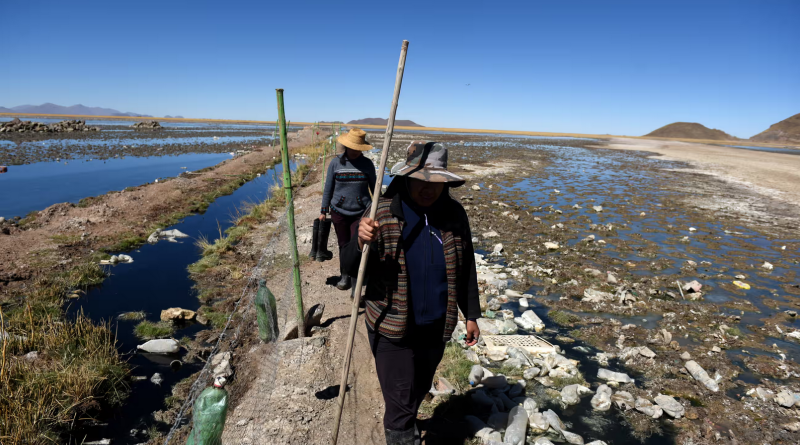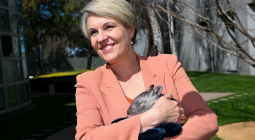‘We empower ourselves’: the women cleaning up Bolivia’s Lake Uru Uru

Dayana and Tatiana Blanco walk amid the rubbish that has accumulated in Lake Uru Uru. The founders of Team Uru Uru found that totora reeds – which have long been used by their Indigenous community to build houses, boats and even floating islands – can absorb heavy metals and other contaminants in the water
Looking out over Lake Uru Uru in the Bolivian highlands, it is hard to imagine that it once supported thousands of people, and was a sanctuary for wildlife, including 76 species of birds.
Plastic waste now stretches as far as the eye can see, the water is tinged black or brown, and the stench is overwhelming.
But in among the filth that chokes the water are submerged rafts that hold thousands of native reeds called totora – a bulrush that can grow to 6 metres and was used to make Lake Titicaca’s famous floating islands. This aquatic plant, Schoenoplectus californicus, has been shown to be very effective at absorbing heavy metals and contaminants.
Made of recycled plastic collected from the lake, the rafts were placed there by the Uru Uru Team, a group of about 50 Indigenous people.
For years, lakeside communities have faced pollution from the mining industry, and from the waste of the nearby city of Oruro. The pollution also threatens flora and fauna in the lake,an internationally recognised wetland under the Ramsar convention.
“It’s very difficult to live and work in these conditions,” says Dayana Blanco, 25, an Aymara woman who is co-founder of the Uru Uru Team and a Fulbright fellow studying peace-building at the University of Massachusetts in the US.
“The smell here is very strong and affects our health. When the sun rises and sets, it is intolerable. I had stomach ache from it once. Who knows what illnesses we could get in the future?”
People living around the lake, situated 3,686 metres above sea level with a surface area of 214 sq km, used it for drinking water, fished in it, irrigated their crops with it and watered their cattle, says Blanco. This is no longer possible and many of the community have been forced to migrate.
The lake used to be home to about 120,000 flamingos but only half that number remain. Years of damage to the lake’s fragile ecosystem has pushed wildlife into a small area of unspoilt habitat.
Changing temperatures and rain patterns have seen Lake Uru Uru’s shoreline recede dramatically over recent years and, as Oruro city has grown, people have built houses in what were protected areas.
Bolivia’s other highland lakes, all protected under Ramsar, face similar threats. Lake Titicaca, which straddles the border between Peru and Bolivia, is grappling with pollution and drought, and population expansion, while Lake Poopó, formerly the second largest after Titicaca, dried up completely in 2015.
“Indigenous people know that if a lake dies, it’s as if the soul of a people dies,” says Tatiana Blanco, 30, Dayana’s sister and in the Uru Uru Team.
“With colonialism and globalisation, new generations have lost their way,” she says.
“They’ve forgotten where they’ve come from and that we are not superior to animals, plants, mountains, lakes and rivers. It is because of this lack of respect and care for nature and mother Earth that there’s an imbalance.”
Fed up with the ever-increasing pollution, the sisters and other young women formed the Uru Uru Team in 2019.
The first step was to clean the water. Their forebears used totora and so they decided to do the same. As well as being used to build floating platforms and houses, totora is important for treating sewage and mining wastewater as it traps minerals in its roots, leaves and stems.
They transplanted about 600 young totora from a place where they grow in abundance and placed them on top of rafts made out of plastic bottles and a grid of sticks.
“We didn’t think the totora would grow, because the pollution is so strong. The water has a lot of heavy minerals,” says Dayana. “But we’ve seen the plants remediating nature little by little and having an effect.”
The team commissioned laboratory tests from Juan Misael Saracho University in Tarija, which found that areas in the lake with totora had reduced pollution by 30%. Flamingos and other birds have begun to return.
The Uru Uru Team has planted about 3,000 totora plants so far. Dayana wants to involve more people from the community, as well as individuals with a background in science and landscape restoration. The team’s aim is to plant 4,000 totora a year and completely clean up the lake to bring back the birds and allow the community to grow vegetables again.
A 2023 Future Rising fellow, she is writing a graphic novel that tells the Uru Uru Team’s story from the perspective of a lake flamingo.
The group has a Facebook page and international organisations, such as the United Nations children’s agency, Unicef, have provided technical support. Last year, the Uru Uru Team won the UN Development Programme’s 14th Equator prize, which celebrates initiatives by Indigenous peoples and other communities in adapting to and mitigating the climate crisis.
The team is constantly looking for solutions to the problems faced by their community. Members volunteer at a school where they established a garden and teach pupils how to grow food, make compost and generate income by collecting plastic and paper to sell for recycling.
“We’ve seen that many families can’t buy vegetables because they’re so expensive,” Tatiana says. “We look for, and develop, initiatives because we’ve learned that we have to take action.
“We have to empower ourselves because nothing will happen if we are just passive and wait for a solution to come from elsewhere.”





